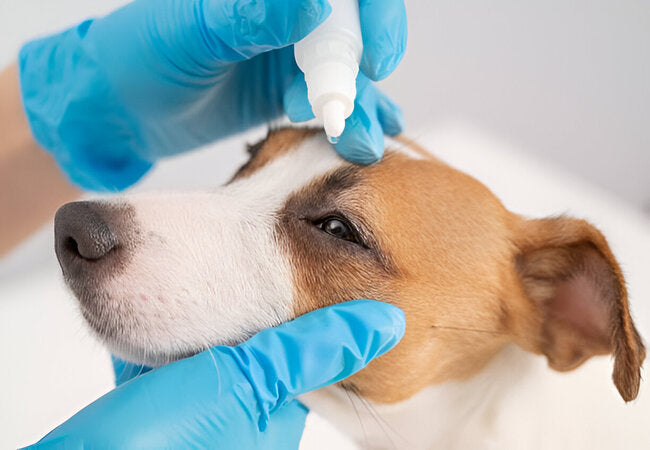2025 Vet Guide: Epiphora in Dogs – Watery Eyes Causes, Diagnosis & Care 🐶💧

In this article
2025 Vet Guide: Epiphora in Dogs – Watery Eyes Causes, Diagnosis & Care 🐶
By Dr. Duncan Houston BVSc
Excessive tearing—known in veterinary medicine as epiphora—is a visible symptom that can arise from many underlying causes. While often benign, it can also signal irritation, infection, or structural issues. Let's explore causes, diagnostics, treatment, and practical care. 👁️
🔎 1. What Is Epiphora?
Epiphora refers to an overflow of tears from the eyes onto the face, often causing dampness and reddish-brown staining from tear pigments like porphyrins.
⚠️ 2. When to Be Concerned
- Clear, watery tear stains—common in certain breeds—but watch for accompanying redness, odor, or irritation.
- Discharge with mucus, pus, green/yellow tint, or signs of corneal ulcer—immediate vet consultation needed.
- Frequent squinting, pawing, facial swelling, or vision issues may indicate pain or serious eye disease.
🧩 3. Common Causes
| Cause Category | Examples | Notes |
|---|---|---|
| Irritation & Inflammation | Pollen, dust, debris, conjunctivitis, corneal ulcers | Triggers tear flushing for comfort. |
| Anatomical & Drainage Issues | Blocked ducts, imperforate puncta, flat faces (brachycephalic breeds) | Prevents normal tear drainage, causing overflow. |
| Eyelid/Eyelash Abnormalities | Entropion, ectropion, distichiasis, ectopic cilia | Rubs or damages the cornea, increasing tear production. |
| Breed Predisposition | Shih Tzu, Pekingese, Maltese, Cocker Spaniel, Bulldogs, Pugs | Anatomy often causes overflow even without disease. |
| Serious Eye Conditions | Glaucoma, dry eye (KCS), keratitis, and nasal masses | Often presents with discomfort, colored discharge, and pigmentation. |
| Infections & Allergies | Bacterial/viral/fungal conjunctivitis, allergic rhinitis | Redness and discharge are likely treatable. |
| Dental Disease | Tooth root abscesses | It can affect nearby tear drainage or irritation. |
🩺 4. Diagnostic Approach
- Comprehensive physical and eye exam, including eyelids, lashes, and cornea inspection.
- Schirmer's tear test to check tear production.—identifies dry eye (KCS).
- Fluorescein dye test reveals corneal ulcers, eyelid penetration, or drainage flow.
- Nasolacrimal flush under sedation to confirm duct patency.
- Assessment for eyelid/eyelash abnormalities such as entropion or distichiasis.
- Measurement of intraocular pressure for glaucoma assessment.
🛠️ 5. Treatment Options
- Remove irritants: Trim hair, clean eyes, keep the environment free from dust and debris.
- Flush ducts: Nasolacrimal irrigation for blocked tear drainage.
- Medicated drops: Antibiotics or anti-inflammatories for infections or ulcers.
- Surgical corrections: Entropion/ectropion repair, eyelash removal, duct openings for congenital defects.
- Chronic diseases: Manage glaucoma, KCS with tear stimulants, or moisture agents.
- Allergy management: Antihistamines or immunotherapy if needed.
🏡 6. Home Care & Prevention
- Clean tear-stained fur daily with a warm, damp cloth; trim fur regularly to avoid irritation.
- Provide a clean, dust-free environment; use humidifiers if air is dry.
- Keep ocular and facial areas dry to prevent bacterial growth—watch for odor or redness.
- Use prescribed eye drops—never over-the-counter peroxide-based cleaners that can harm the eye.
- Prevent injuries: supervise outdoor activity and wear protective gear during windy conditions.
📱 7. Monitoring & Support Tools
- Ask A Vet: Remote guidance for tear staining, medication timing, and urgent care decisions.
- Woopf: Log symptoms, treatments, triggers, and vet follow-up visits.
- Purrz: Track tear color, eye comfort, cleaning routines, and progression over time.
📚 Frequently Asked Questions
Q: Is epiphora normal in flat-faced breeds?
Yes—it can be normal due to anatomy. However, persistent staining or signs of infection should still prompt veterinary evaluation.
Q: What if the tears are discolored?
Green/yellow suggests infection; mucus or crusting indicates inflammation—consult your vet if you observe these signs.
Q: Can tear stains be prevented?
Regular facial cleaning, keeping the area dry, trimming hair, and flushing ducts help prevent staining and secondary infection.
💬 Owner Insight
> “Our Maltese always had tear stains until vet flushed her ducts and we cleaned daily. Now her face stays clean and eyes are bright!”
🏁 Final Thoughts from Dr Houston
Epiphora is more than cosmetic—it’s a sign your dog may be experiencing irritation, anatomical, or disease-related issues. With proper diagnostics, targeted treatment, and supportive home care including Ask A Vet, Woopf, and Purrz tracking, you can help keep your dog’s eyes healthy and stain-free into 2025 and beyond. 💙👁️
Download the Ask A Vet app for tear-stain support, symptom tracking, and veterinary guidance. 📱
AskAVet.com – Proudly helping your pup see and feel their best.






